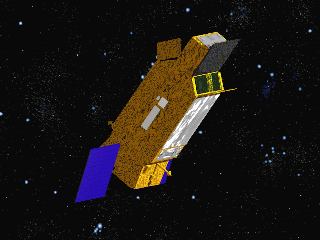

Mission Status Report #54 Star Date: January 28, 2002
Almost Back in Business!Caption: FUSE Science Operations have been on hold since Dec. 10, 2001, while we recovered from a problem with our pointing system. The recovery has progressed very well over the last two weeks. The report below provides an update. (Graphic of FUSE with doors open, courtesy of the Canadian Space Agency.) (Click image above to see larger version.)
Hello World, I am happy to report that the last two weeks have seen continued progress toward recovering science operations with the FUSE satellite. The anomaly we experienced on December 10, 2001, involved the Reaction Wheels, as described in a previous report. Since the last report (January 15), we have achieved several milestones. The telescope doors have been reopened (Jan. 16), and the high voltage on both detectors successfully brough up to full operational values (Jan. 17-18). Exposures on "blank sky" positions were made through the following weekend, verifying that the FES guide camera, detectors, and spectrograph are all working correctly, and suffered no obvious ill effects from the downtime! While this initial checkout was underway, a parallel effort continued to finalize and test the new software that will control the satellite and plan for uplinking it to the satellite. On Thursday Jan. 24, the control center was a-buzz with activity as the software was uplinked and put into action. A set of test slews (motions from one pointing position to another) were executed during Jan. 24 - 27, all in and near the continuous viewing zone near the pole of our orbit. These tests were successful and provided us with much information about how things will work with the "new FUSE." It may take longer for us to move from place to place in the sky, but disturbances settle out quickly at the end of each motion, and tracking information shows pointing jitter to be small most of the time. Since we expect disturbances to be small near the orbit pole, this all confirms our expectations. We are nearing the point where some limited science observing can begin again! You should note that we have not given up on trying to recover the pitch reaction wheel. It would still be very beneficial to get a third reaction wheel back in the control loop. With the fix that is in place now, it is like we have a "strong muscle" on two axes of motion and a "weak muscle" (the magnetic torquer bars) on the third axis, and we would rather have three strong muscles! However, attempts so far to spin the wheel have been unsuccessful. But we will keep trying! In reality, we still have a lot of work to do. We need to test larger slews and move around the sky to understand thoroughly where disturbances are small enough that we can operate effectively. We have to revise procedures for how we do alignments and various target acquisitions, and then modify our ground support software for the behavior we see on-orbit. But all in all, it is only a matter of time now before we are back to doing science observations! We congratulate all of the fine engineers and scientists at Orbital Sciences Corporation and at JHU who have worked so hard over the last month and a half to get us to this point. Reported by: Bill Blair, Chief of Observatory Operations More information on Reaction Wheels Status Message released 1/28/02, 3 p.m.
|
